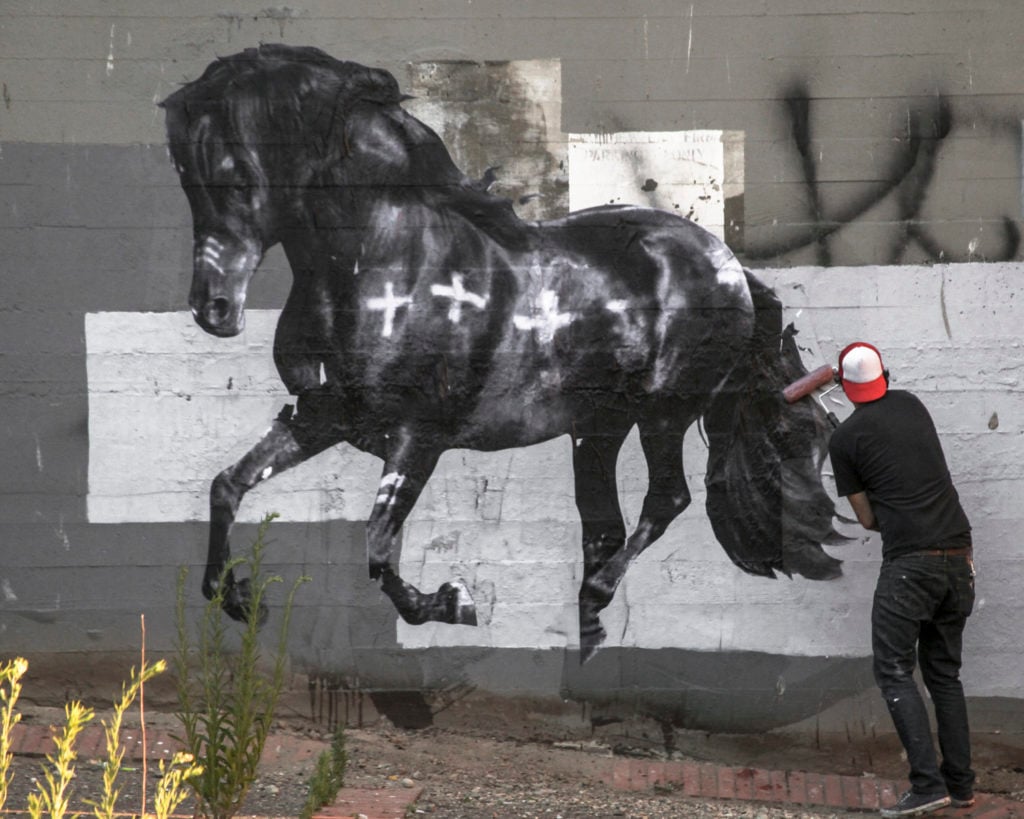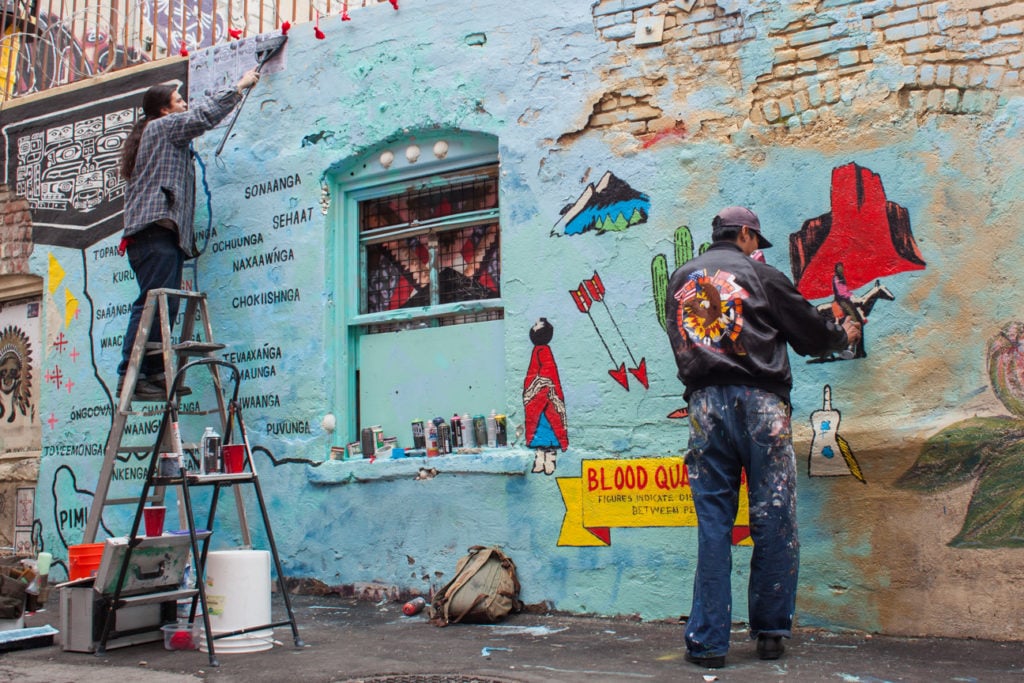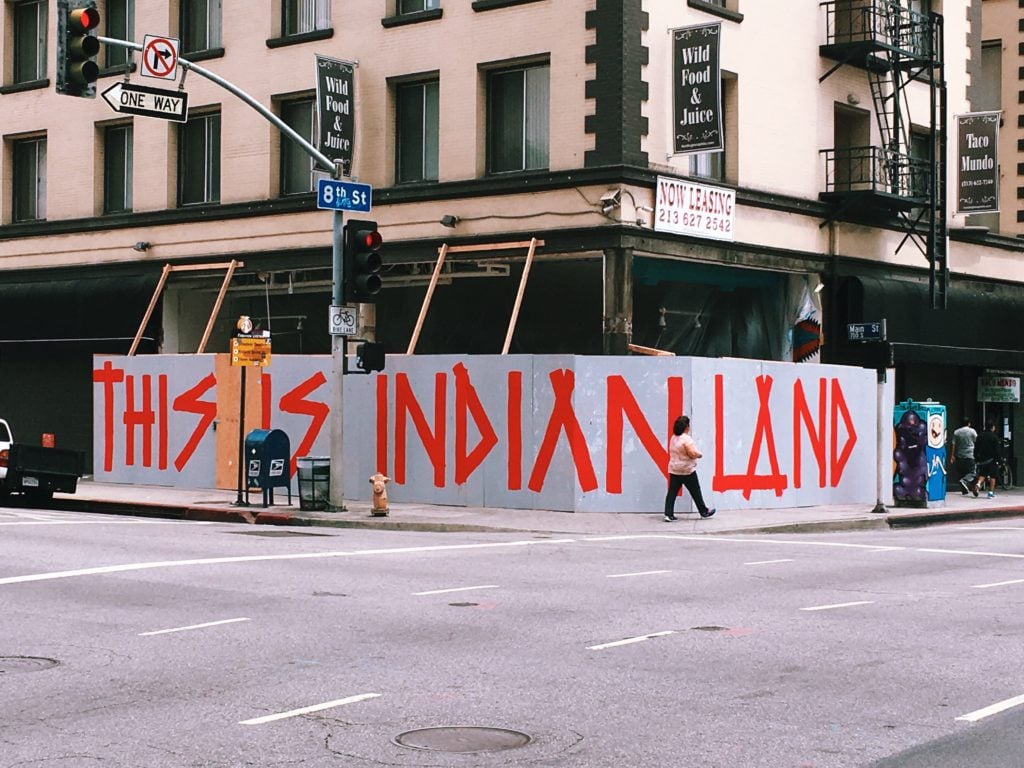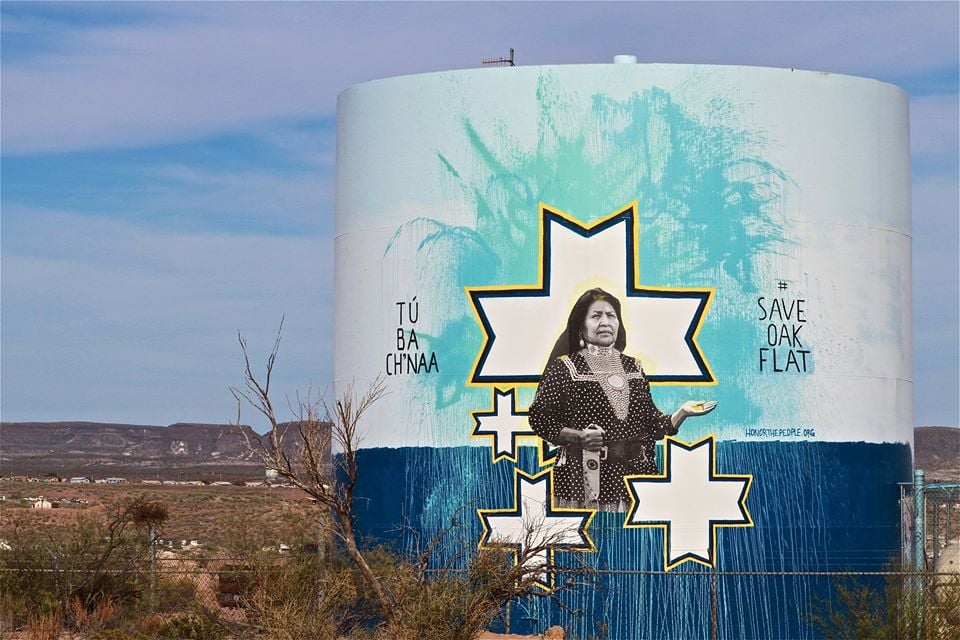Art World
How a New Generation of Native American Street Artists Is Leaving Its Mark Across the United States
In cities and rural areas across the US, a movement is taking shape.

In cities and rural areas across the US, a movement is taking shape.

Karen Chernick

Ten years ago, an illegal street sign helped put Indian Alley on the art-world map.
In 2010, Los Angeles-based artist Wild Life installed an imitation street marker above the city-sanctioned sign for Wendin Place in LA’s Skid Row. His sign renamed the street “Indian Alley, Property of the People,” a play on official signage (which would normally say “Property of Los Angeles”).
Renaming the street after an already existing nickname, Wild Life kicked off a movement to make the area’s Native American history visible with site-specific murals and graffiti created exclusively by Native artists.
For years, this alley in a notoriously impoverished area adjoined the offices of United American Indian Involvement, an organization helping Native people fight homelessness and addiction. By the time Stephen and Jodi Ziegler, owners of the These Days art gallery, moved into a nearby building in 2008, the organization had relocated, but its presence was still ingrained.
“This is a very special place for me, and I consider it sacred ground,” Stephen Ziegler tells Artnet News. “There was no romanticism about it. It was a filthy, crime-ridden alley that a lot of people died in, and overdosed in, and drank themselves to death in, and were killed in. There’s not a grandiose, proud, Indian-feather-headdress cliché [feeling] to it. To me, this place represents the result of genocide, and the lowest [place] that a people can end up.”
After doing some research on the area’s past, the Zieglers invited a group of artists to create murals on a building they own in the alley, and other projects have blossomed since. In 2018, Native artists Jaque Fragua and River Garza created a mural charting all of Los Angeles’s original village names.
“I just saw it as a very educational thing for people, to remember that this was someone else’s land,” Ziegler says of the mural.

River Garza and Jaque Fragua collaborate on a mural in LA’s Indian Alley, 2018. Photo by Stephen Ziegler.
Indian Alley is the rare urban site that concentrates such art. But elsewhere, Native American artists are creating murals, outdoor artworks, and graffiti that is often informed by their heritage, but does not always include typical iconography.
“I don’t feel the desire to include eagle feathers and things like that,” says Cheyenne Randall, a Seattle-based artist of Sioux Lakota descent. “I like to do whatever I want to do, and then if you want to call it Native artwork, you can, because I’m Native myself.”
To make his works, Randall Photoshops tattoos onto vintage photographs of Hollywood stars and musicians. The finished images are then enlarged, printed, and wheat-pasted outside. In similar works where Randall depicts Native people, the idea, as he explains on his website, is to emphasize “the fact that Native America was and is still here.”

Jaque Fragua, This is Indian Land (2016).
For others, like Fragua, making art outdoors is an inherently indigenous act. Fragua grew up in Jemez Pueblo, the last Towa-speaking community in the United States—a town not far from the Petroglyph National Monument, where art depicting people, animals, and geometric figures dates back thousands of years.
“I see graffiti as a primordial art form of mark-making that started on caves and rocks as petroglyphs or pictographs,” Fragua says. “The language is a bit different in modern times, but the spirit of visual storytelling is still there.”
In 2016, Fragua got a flurry of press attention when he graffitied “This Is Indian Land” on a temporary construction wall in LA. But around half of his public artworks have been made on reservations outside of big cities, where he appropriates abandoned highway billboards.
“Billboards and signs that market commercial activity pollute the psyche and perpetuate toxic social environments,” he says. He creates what he calls “interventions” in their place, writing messages—”Sacred” and “Stop Coal,” among others—that are relevant to the people who live there.
“Agency is imperative for Native Americans, more than ever,” Fragua says. “Any contribution for our people from our own people is a positive step forward.”
Together with other indigenous artists, including Randall, Fragua took part in an organization called Honor the Treaties, which aimed to amplify the voices of indigenous communities by having artists collaborate with Native advocacy groups to broadcast their messages to wider audiences. Among the issues that Honor the Treaties addressed were environmental destruction, illegal mining, and land rights.

Tommy GreyEyes, Save Oak Flat (2014).
To protest the development of a proposed copper mine at Oak Float, a sacred site in Arizona long used for Apache coming-of-age ceremonies, Honor the Treaties brought together Tommy GreyEyes, a Navajo Nation artist, with members of the San Carlos Apache tribe. The artist enlarged a photo of an Native woman with a knife and wheat-pasted it onto a water tank across from the only grocery store in the area. “Everyone saw it,” he recalls. “The text on the image read, Tu ba Ch’naa, which means water is life.”
“We were able to share our message in a way that touched people who would otherwise be unaware of the issues,” he says. “In a lot of ways, using street art to convey these messages helped to propel ideas to become actual movements.”
Meanwhile, on GreyEyes’s own reservation in northern Arizona, a series of outdoor artworks by both indigenous and non-Native artists from across the United States relate the history of the region and its people. Collectively called the Painted Desert Project, the program was initiated in 2009 by Chip Thomas, a family doctor who has lived and worked around the reservation for over 30 years.

Indian Alley. Photo by Stephen Ziegler.
Some indigenous artists, including Fragua, feel that only Native American artists should be permitted to make work on these reservations. But GreyEyes says collaborations are opportunities.
“I got to influence my colleagues by sharing parts of the Navajo way,” he says. “I saw my colleagues honoring the ways of Navajos through their art.”
For now, the Painted Desert Project and Indian Alley appear to be the only places where Native American-made murals are being concentrated.
“I wish there were more public spaces like that,” Randall says.
“There’s not really anything else in the country,” Ziegler adds. “In this whole country, with all these people, why isn’t there more?”